Are you searching for the best blogging platforms in 2023? This article aims to guide you through the top blogging platforms in 2023, exploring their features, usability, customization options, and overall performance.
By delving into this comprehensive analysis, you will gain valuable insights that will enable you to make an informed decision and select the best platform that aligns with your blogging goals.
Let us get right into it.
Best Blogging Platforms in 2023
1) WordPress
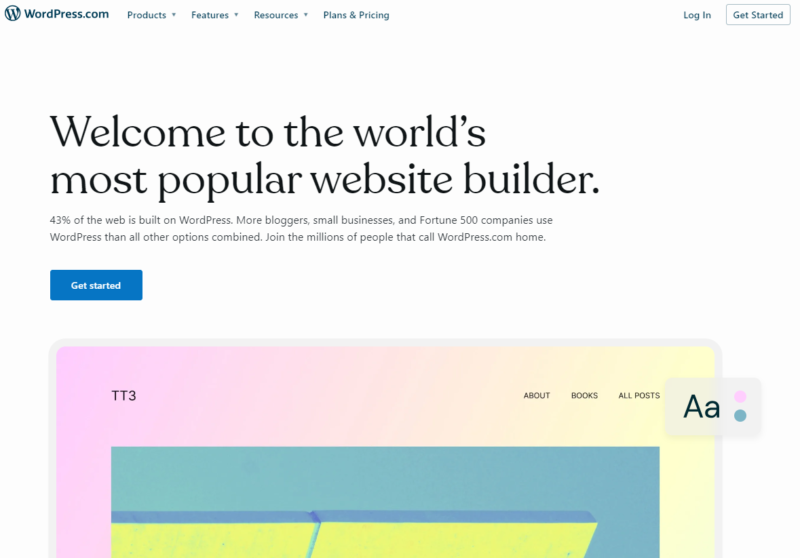 The most used blogging platform worldwide is WordPress. It’s free to use, and the creative possibilities are endless.
The most used blogging platform worldwide is WordPress. It’s free to use, and the creative possibilities are endless.
WordPress.com offers free blogging services. The business provides you with a subdomain and hosts your website. The drawback is that, unless you increase your plan, it is supported by serving its own advertisements.
As an alternative, you can utilize the platform on a website you host yourself by downloading it for free from WordPress.org. Even though hosting isn’t free, using a top-notch WordPress host like Hostinger makes the whole process less expensive than using a comparable website builder.
The benefit is that you can create anything you can think of with a WordPress blog.
Although the distinction between WordPress.com and WordPress.org can be a little perplexing, both alternatives use the same platform. For me, WordPress.org is better since you have complete freedom to bend and mould the platform to make it appear and operate exactly how you want it to.
Also, using WordPress.org and paying a hosting company for web hosting is frequently a more economical choice than purchasing a WordPress.com subscription.
Regardless of the path you take, picking a WordPress theme is the first step. Imagine it as a template that formats your entire website rather than just a single page. Many fantastic free themes are available to help you showcase your work. They will help you curate posts for your followers and keep your blog consistent with your brand.
There are tens of thousands of WordPress plugins available that you may use to increase the functionality of your blog. They are useful for many things, including SEO, website security, creating newsletter subscriptions, and much more. Many helpful plugins are available for no cost.
You may also purchase premium plugins and themes to give your website more features or a unique design.
Due to its open-source nature and astronomical popularity, WordPress has a vibrant community that is always creating new features to address contemporary problems. Just a few of the factors that influence more individuals to select WordPress for their site include:
- 55,000+ plugins that increase your site’s functionality
- Hundreds of themes, both free and paid
- blocks in the Gutenburg editor
- advanced permissions and responsibilities for users
- effective media management
- a vast community of professionals
- endless design flexibility
If you can’t, someone is undoubtedly working on a solution right now. You can acquire plugins and themes to take your site wherever it needs to go.
You pay for an all-in-one platform with Wix and Squarespace. With WordPress, you may buy what you need à la carte and the platform is free. To get what you need, mix and match your own plugins and themes.
Make your site a social media platform or host content that is exclusively accessible to members behind a paywall. Finding the appropriate plugin is all it takes to get anything you want.
Even at beginning, Wix will be simpler to use than WordPress, which is by no means a challenge.
Sure, it may take more work to maintain a truly intricate site with numerous plugins, but you’ll also have a blog that is far more distinctive than one you might put together on Wix.
Yet, WordPress makes regular editing a breeze. The process of organizing and improving your blog is made easier with the Gutenberg editor. You can easily add content from your media while working in HTML or visually editing blocks of text.
It is relatively simple for a non-technical user to create a personalized blog that is rich in photographs and videos. Gutenberg can also assist you in reducing the number of plugins you use, as employing too many can start to cause conflicts.
When examining the total costs associated with utilizing WordPress as a blogging platform, it truly depends on what you want to accomplish. Obviously, the platform version you utilize as well.
WordPress.com offers a fully free initial setup, but there are a number of premium plans that provide you greater flexibility. As an illustration, you can get rid of WordPress ads and get a custom domain for free for a year for just $4 per month. These packages have a maximum monthly cost of $45 for an e-commerce-specific bundle.
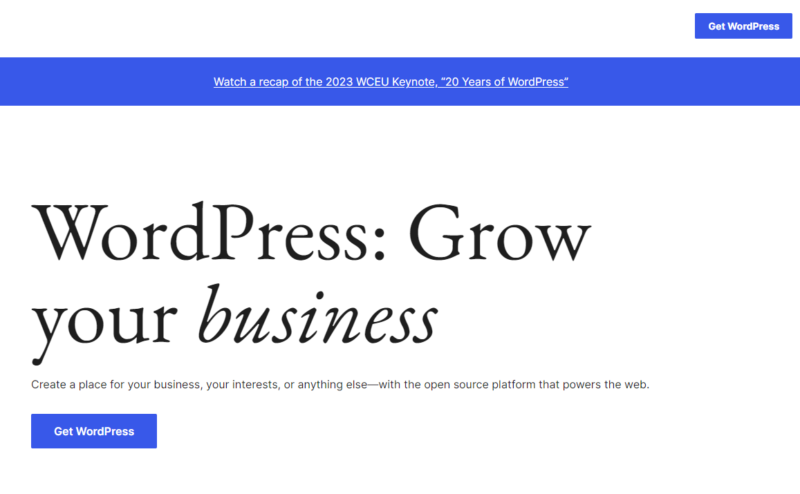 Nonetheless, WordPress.org is permanently cost-free. Just remember to account for the accompanying costs.
Nonetheless, WordPress.org is permanently cost-free. Just remember to account for the accompanying costs.
The use of themes and plugins is one such expense. There are a lot of free options, however paying for premium options is usually necessary.
The other significant one is hosting, which WordPress.org requires of you. But don’t worry, you can get fantastic hosting for a lot less money each month than any of WordPress.com’s paid plans.
I suggest Hostinger’s WordPress Starter hosting plan if you are just starting your blog.
2) Wix
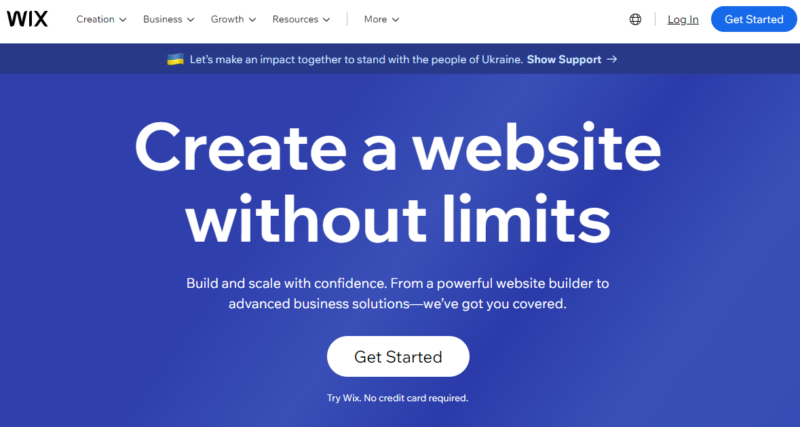
Use Wix if you want to be as close as possible to a functioning blog. There are some other excellent solutions on my list, but none are as simple to use. It’s a great option for novices who want to build a fully functional website with a blog.
Simply build your website using the drag-and-drop editor to get everything set up. There is no need for code.
Although Wix heavily relies on templates, an astounding array of choices exist. You can select anything that complements your brand and modify it to fit the mental picture you have in your head.
Instead, Wix Artificial Design Intelligence is an option (ADI). Wix ADI will construct a website for you after you respond to a few questions about yourself and the goal of your blog. No, I’m not joking.
Even if you want to create your own website, Wix ADI will assist you in determining the best layouts by allowing you to see your content before choosing one.
Very little configuration on your end is necessary for everything to look sharp. Whether customers are seeing your final product on a laptop or a smartphone, it will have a professional appearance.
And don’t worry if you’re always on the move. With the Wix mobile application, you can design and blog directly from your phone.
Wix is brimming with effective solutions to help you broaden your audience and engage with them in meaningful ways online:
- best SEO tools in the industry
- tools for social media
- Visitor information
- scheduling after
- HTML embed codes
- Tags and categories
- sophisticated search capabilities
- Collaborators
- simple photo editing
Wix is much more than simply a blogging platform; it can be used for site construction and outreach. It is available right now and is completely free to use.
The world-class site development tools are still available to you with a free Wix account, keeping things straightforward. Nevertheless, your website’s web address will be wixsite.com, and you’re only allowed 500GB of bandwidth, so it essentially only works for small sites with little traffic.
The Wix advertisements, which allow the business to provide the free version, are the second disadvantage of the free-forever plan. Do you truly want adverts from other businesses if you run your blog as a part of your business?
Ads are removed and you receive a custom domain name for free for the first year if you upgrade with Wix. Your site is entirely yours, which I believe makes it worthwhile.
Websites, Business and Ecommerce, and Enterprise are the three categories into which premium Wix plans are divided.
Wix features a couple of plans that will do the trick if you search for a pure blogging platform.
Plans range from $16 for Combo, which is suitable for personal use, to $45 for VIP, which offers a lot more storage space and tools to help you build your business. Web hosting, which typically costs about $10 per month, is included at this price. Actually, Wix’s premium plan comes with everything you need.
Plans for businesses and e-commerce, which enable you to take payments online and offer goods and services directly from your blog, start at $27 per month. The Wix setup procedure will still be incredibly user-friendly even for more complicated sites.
For people and small businesses looking to spread the word, Wix is a great option. On Wix websites, there is a cap of 100 pages (excluding blog entries, obviously), and site speed may suffer if you start to exceed this number.
If this is a worry, I would simply use WordPress because it can expand as much as you require. Yet, Wix provides specialized business clients with solutions starting at $500 per month.
Wix is excellent for the majority of customers, especially those who want to launch their blog without any stress or hassle.
3) Squarespace
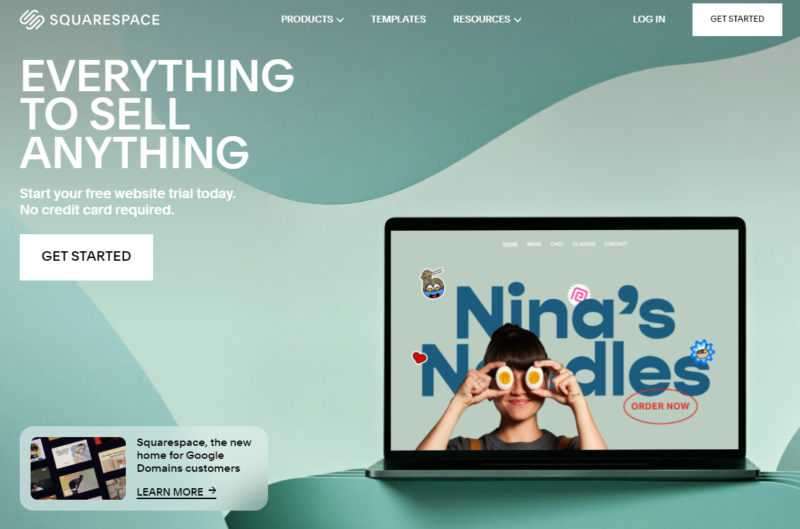
Like Wix, Squarespace is an all-in-one website builder. Yet it’s renowned for having beautiful templates, which makes it ideal for industries reliant on images, like those of photographers, designers, and painters.
You could assume that everyone employs a designer to get to Squarespace blogs’ crisp, lovely brand presentation. It’s possible that it’s their very first website ever.
Don’t misunderstand me. Squarespace can be used to create stunning websites by experts in graphic design, but I believe that its appeal lies in the ease with which non-technical people can create visually appealing websites.
Squarespace is a fantastic option for the entrepreneur or small business looking to develop their online presence. They won’t need to pay a web designer or developer to create the slick blog they want.
This is significant since you won’t have to hire someone to make your website or struggle to locate help when something goes wrong.
And if something does go wrong, Squarespace’s excellent customer care is readily accessible around-the-clock. The sitebuilder’s very low monthly price is undoubtedly much less expensive than paying a freelance designer on retainer.
Consider of Squarespace as a compromise between Wix and WordPress; it offers slightly more customization options than Wix, but not quite as many as WordPress. Yet, it will be simpler to use than WordPress right away.
Similar to Wix, you begin with templates and then modify. There is no need for coding to get sta You don’t need to continuously evaluate your page to ensure that everything is positioned correctly because what you see is what you get in terms of style.
Although the Squarespace UI isn’t as user-friendly as Wix’s, getting the hang of it isn’t difficult. And once you do, you’ll discover that you have more control over the layout and color scheme.
Because of this freedom, Squarespace attracts a lot of creatives, designers, and artists.
To create a classy blog using Squarespace, you don’t necessarily need to be a designer. Every day, people who have no artistic talent at all create incredible sites on the platform.rted because Squarespace templates are quite attractive and the editor is drag-and-drop.
Squarespace is ideal for a business that wants a stunning blog but doesn’t want to pay a designer to take care of it.
When you open the box, you get:
- Tags, categories, and highlighted posts
- Integrated post scheduler
- Contributor authorization
- detailed analytics
- tools for social media and SEO
- Tools for email marketing
- professional client service
- mobile application
No longer will you have complete customization options as you had with WordPress’s tens of thousands of plugins. Having said that, Squarespace has built-in support for all third-party extensions and add-ons, so you won’t need to worry about updates or upkeep.
It’s quite simple to add e-commerce capabilities to your Squarespace blog. Create and sell member-only material, set up an online store, or schedule appointments.
With Squarespace’s great marketing and SEO capabilities, you can set up these features in a matter of minutes and attract the proper kind of readers to your site. Just as simple to set up as your blog, your company website will have everything you need to seem professional.
The Personal tier of Squarespace plans starts at $16 per month for a website. Through the Business tier, they may add ecommerce features for as little as $23 per month. This is the annual subscription fee, however you can also pay monthly for the Personal tier for $23 and the Business tier for $33.
A really attractive blog can be powered by the Personal plan more than adequately. Together with access to the fundamental website analytics and the Squarespace extensions, which enable you to enhance your site with third-party features and content, you also receive the comprehensive design and editing tools that I’ve just mentioned.
With the Business plan, you may expand the customization of your website and accept safe online payments. Accept reservations, schedule appointments, or transact sales of goods and services. The quantity of goods you can offer for sale on the Business tier is unrestricted. Choose the features you want, and let Squarespace handle the upkeep.
A free Google Workspace account is also included in the Business tier for the first year. As a result, you get a business email address that you can control through Google.
For your e-commerce site, the Business plan will cost you a 3% transaction fee. You must upgrade to one of the more expensive tiers if you wish to avoid this cost.
I appreciate the Business Plan since it offers more sophisticated data to help you understand your target market and improve your marketing campaign. You’ll gain more e-commerce features and tools to better understand your website traffic with higher tier plans.
You have 24/7 access to Squarespace customer service, regardless of the plan you select. The help is constantly available, which is a tremendous comfort for businesses wanting to manage without a web designer.
Squarespace is a wonderful choice that keeps getting better. The company is continually updating the UI and adding new features.
4) Medium
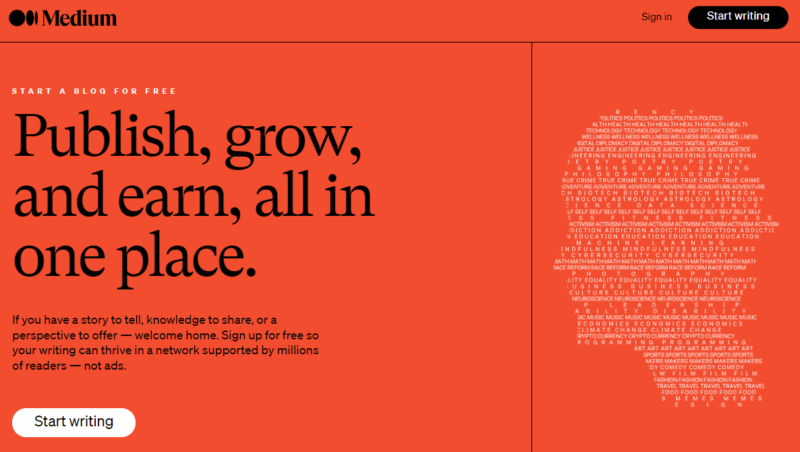 You won’t need to concern yourself with web hosting, design, upkeep, or building your own website. For bloggers who simply want to write and get paid without doing anything else, it’s the ideal choice.
You won’t need to concern yourself with web hosting, design, upkeep, or building your own website. For bloggers who simply want to write and get paid without doing anything else, it’s the ideal choice.
The best part is that Medium already has an audience. As a result, you won’t need to worry about getting readers for your blogs.
There are endless subjects on which you can write. Simply sign up for the Medium Partner Program to earn money when people read your blogs.
This is a fantastic chance to connect with niche audiences interested in your expertise. When your name is published alongside some of the most well-known bloggers in your area, you can quickly establish brand authority.
Even while you won’t be able to make millions of dollars writing for Medium, it’s still a simple way to start a blog. Also, you can get paid for your work.
For those of you who want to create your online identity, Medium provides a free blogging platform. But, it isn’t quite as strong as website builders like Squarespace regarding design flexibility.
Medium is a terrific platform for individual bloggers and corporations to promote their work.
You can begin to compile a portfolio of content, daily updates, client success tales, trending news stories, and whatever else comes to mind. You can post your work on social media with just one click and interact with curated audiences for free, thanks to Medium.
5) Blogger
 Blogger is an excellent platform for amateur bloggers, those who want to promote a cause, and possibly businesses that only want a standard blog.
Blogger is an excellent platform for amateur bloggers, those who want to promote a cause, and possibly businesses that only want a standard blog.
With the same level of dependability and user-friendly navigation as Chrome and Gmail, it is owned by Google. Blogger posts can be written if you can write an email.
It also comes with your own subdomain and is totally free forever. Example.blogspot.com will be the address of your website. Getting up only takes a few minutes, and you never have to worry about hosting, file storage, or maintaining a fast site.
Simply get your custom domain from one of the finest domain registrars if you want to develop an on-brand blog and get rid of the blogspot subdomain. Everything may be set up with ease, especially if you utilize Google Domains.
I prefer it for personal use because the platform’s limitations may constrain a blog created for corporate purposes. The blog presentation can be adjusted, but you can’t change it too much to make it uniquely yours.
There are devices to enhance your blog’s functionality, but none come close to matching the strength and variety of WordPress plugins. Also, unlike other website builders, you don’t have any e-commerce possibilities.
Having said that, utilizing Google Adsense, you may easily monetize your Blogger page. After you submit a brief form with your payment details, Blogger will place relevant adverts on your website and charge you based on how many people view them.
While this won’t get you a full-time job, having some money flowing in the door from your blog can’t hurt. You get everything you need to get started, including:
- Google Photos provides image storage
- Integrated marketing campaigns
- an easy text editor
- Free domain mapping and an SSL certificate
- integrate Google
Consider Blogger to be a low-maintenance, low-stress blogging platform. It works great for those who want to tell a narrative but aren’t ready to devote a lot of time and money to their blog.
Your tale can be about whatever you desire, including your life, your brand, or your neighborhood. Google takes care of all the technological grunt work, while Blogger provides you with a platform to spread your message. You don’t need to be concerned about website backups or hacking.
Blogger is a good option if aesthetics aren’t your top concern. The variety of templates is somewhat limited, and advanced customizations require knowledge of HTML.
With interactive content and dynamic pages, you won’t be able to give your readers a really unique experience as simply as you can with a website builder like Wix.
On the internet, Blogger templates are used repeatedly. If you don’t mind that, Blogger will be one of the simplest and least expensive options to start your blog. If you want a standard blog, pick Blogger. You’ll be able to start a readable blog with little work and supervision.
Factors To Consider When Looking For The Best Blogging Platforms
Cost and Income
Making a profit isn’t the main goal for all bloggers. They do not depend on blog income to support themselves, but it would be nice if they could earn a little additional money.
If you belong to this category, I strongly advise you to check out Blogger and Medium.
These two well-known blogging sites are unrestrictedly free. You don’t have to worry about the website’s uptime or pay for web hosting or design. These companies take care of everything.
Although Wix and WordPress have free versions, I prefer Medium and Blogger because they don’t display vendor advertisements on your website. Blogger enables you to run advertising and keep all the revenue.
If people read your blog entries on Medium, you can make money from them through their Partner Program. You may get your posts in front of new readers interested in your blogging area by using the program, which is free to join and requires no effort.
For an additional source of income, you may include affiliate links in your Medium posts. You aren’t able to do this on all free platforms.
I’ll recommend Wix, Squarespace, and WordPress if you want to use the platform for your business or start earning serious money from your blog. Although these solutions aren’t free, they offer a lot of value.
For example, you’ll be able to put content behind a membership paywall and accept payments for goods and services. The free platforms offer a few ways to make money, but they do not support e-commerce.
Throughout this essay, I’ll go into more detail about the advantages of premium blogging platforms, but the bottom line is that the more functionality you want from your blog, the more money it will cost.
Examine their services before choosing between the premium platforms because one may have better pricing suited to your need.
For instance, Wix offers all-inclusive plans that include everything you need to launch a website. You are ready to launch after selecting a plan for e-commerce or a basic blog.
WordPress, on the other hand, costs money to host but is free to download. Squarespace and Wix handle hosting and include the cost in the final price.
You’ll discover, though, that hosting your own WordPress site frequently works out to be less expensive than purchasing everything at once.
Although it requires a bit more work, you have far more control. You can install WordPress plugins and themes independently, instead of purchasing a set of functionality and layouts.
Be sure the plan you’re considering has sufficient resources to support your website. The entry-level layouts could not be eligible due to storage and traffic limitations.
This isn’t a major problem if you are just starting off. Nevertheless, once you start getting a lot of traffic or adding a lot of features to your site, performance may suffer. No one reads blogs that take a long time to load.
Creating Your Own Blog Rules
Does your brand include your blog? This is significant when considering blogging platforms because some of your free options will restrict your ability to regulate branding.
By displaying their own advertisements on your website, WordPress and Wix support their freemium features. You have no say over what they sell or how much money they make. It’s not a major concern for a hobby blog, but it’s not ideal for a company.
However, there are no advertising on Blogger and Medium. Hence, if you want a free blog to advertise your company, I’d recommend starting with one of those two.
To strengthen your brand, you should also own your own domain name. Free blogs provide a subdomain that includes their brand in your website URL. Yourusername.blogspot.com would be your URL on Blogger.
Purchasing your own domain name is simple and makes you appear much more professional. Also, it helps search engines like Google send the appropriate visitors to your website.
You can get that unique web address without having to worry about someone else’s brand, thanks to Wix and Squarespace’s free domain name for the first year.
WordPress hosting via Hostinger also entitles you to a free domain name for the first year. This, in my opinion, is the ideal approach to launch a WordPress blog.
Freedom in Design
Simple tools are available to produce, manage, and share content on Blogger and Medium. The layout is limited in what it can do, but it will always look good.
You have a lot more control and design flexibility with the premium blogging systems, enabling you to create an entire website and brand around your blog.
Instead of having to color inside the lines that someone else has drawn, you may customize almost every aspect of the look and feel of your blog.
I heartily endorse Wix for new bloggers who desire an own website. The learning curve is quite low; you can drag and drop your way to any website you like.
Design-wise, Squarespace is incredibly user-friendly. The process of creating a site may take a novice user a little longer than it would with Wix, but you have more control over the look and feel of your blog as a result.
It’s one of the factors that makes Squarespace the platform of choice for many creatives, including architects, photographers, and others.
The most flexible platform for design is WordPress. Although there is a slight learning curve, there is not much you cannot do. It’s certainly doable, though a little more challenging at first than Wix.
But, a WordPress blog is your passport to limitless possibility if you’re seeking for the freedom to create.
Prerequisites for upkeep
Medium and Blogger are going to be a huge hit with people who desire a hands-off blogging experience. Other from posting your articles, you don’t need to worry about hosting, updates, or practically anything else.
When it comes to upkeep, Wix and Squarespace are still quite hands-off. They can do all the backend work that most bloggers aren’t enthusiastic about, including hosting your blog, managing SSL certificates, patching security holes, and more.
To get started with WordPress, you’ll need to purchase web hosting and a domain name. You’ll eventually need to upgrade both WordPress and any plugins and themes you use. It needs the most care because it is the most flexible and adjustable platform.
For this reason, I advise individuals using Hostinger when launching their first WordPress blog. You can obtain WordPress hosting with automatic WordPress updates and a free domain name for the first year for less than $4 per month.
Get everything you require in one location, and let Hostinger handle some of the fundamental upkeep.
Resources for Expanding Your Audience
The fact that each of these blogging platforms has features that make it simpler to connect more people is one of the main reasons I suggest them.
With these methods, you may increase the size of your blog audience, which could include readers, clients, or other enthusiasts.
even the cost-free ones. Blogger tracks visitor behavior on your website and informs you of their origins. Integrate Google Analytics to have a better understanding of what’s going on.
Moreover, Blogger interacts with well-known email marketing platforms, converting your blog into a newsletter.
Paying readers are already part of Medium’s readership. If you sign up for the Partner Program, Medium will select your work for visitors looking for related blog pieces.
Also, it’s simple to share your Medium posts on social media, reaching a huge number of people with only a few clicks.
These are only the options that are free. The quality and variety of your growth features greatly rise if you use a premium platform.
You may create your list using Squarespace’s free email marketing tools. For the purpose of automating tens of thousands of sends each month, you can also add on premium email marketing solutions.
WordPress enables you to engage your audience and spread your message along any imaginable axis. Employ plugins to increase the traffic to your blog or make your website an SEO powerhouse. Tens of thousands of plugins are available, and a sizable user base continuously develops new solutions.
The basic line is that you cannot simply curate posts and hope that everyone would understand it if you want people to read your blog. Cast a wider net via social media and other avenues to enhance traffic.
Conclusion
I advise visiting the vendors’ websites and reading their blogs if you still have problems picking which blogging platform to use.
If you want to give your readers a distinctive blog experience, WordPress is my #1 recommendation. There are no restrictions on what you may make, and if you choose a trustworthy low-cost web host like Hostinger, it might be less expensive than the all-in-one website builders.
To get a sense of how the designer works, Wix will even allow you start modifying a sample blog straight on their website. If you enjoy it, you can start creating your own Wix blog right away.
Wix ought to be your first pick if you want to quickly launch a beautiful blog and have no prior web development skills.
See Also
